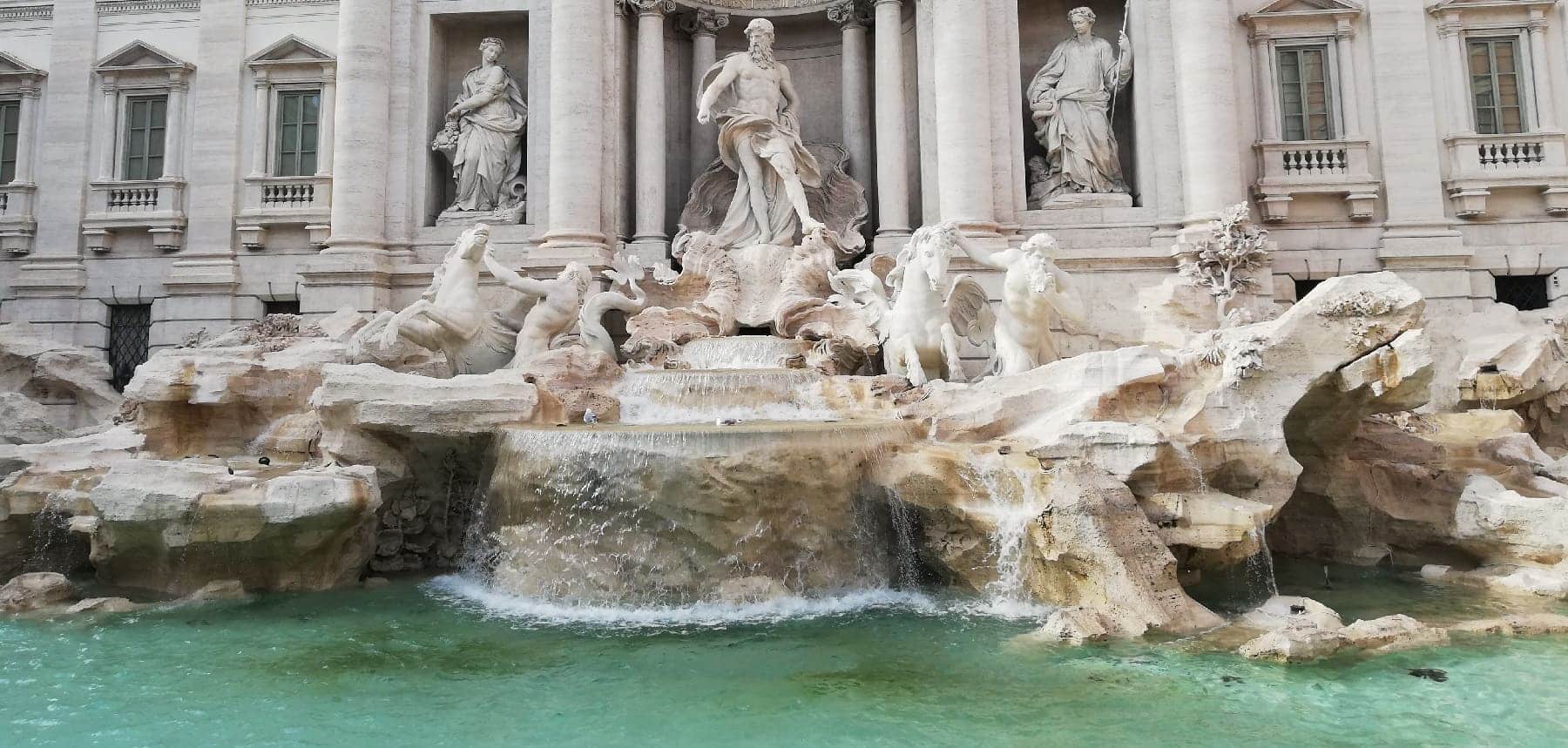The Trevi Fountain in Rome is undoubtedly one of the most evocative places in the Italian capital and in the world. It is a representative cultural property of Italy and art is infused throughout the monument.
It is a very special site, famous everywhere, whose celebration of water, matter and the change it represents leaves tourists speechless.
But the very triumph of aesthetics is embodied in the wondrous forms of nature: what we might call a “motu perpetuum” of the universe itself embodied in the Urbe. We could find a reason for you to visit the Trevi Fountain, but that would be very reductive because there are so many of them. It is not possible to see Rome without being lulled by the charm of the Trevi Fountain.
Approaching the site, even from Via del Corso and Via del Tritone, you can see it, and feel it thanks to the vibrations of passers-by, tourists and Romans who constantly admire its splendour. If it is true that beauty escapes and flees time, this is not the case with the Trevi Fountain.
If you find yourself near the Pantheon, just walk a little, passing through the picturesque streets of the capital of Italy, you will quickly find yourself in front of this emblematic place which has also inspired cinema. This fountain of character will rock you with its impetuous and sensual waters which crash against Bernini’s marble.
It emanates from there waves and an emotional intensity that only this place can give you. Rome’s Trevi Fountain celebrities have chosen it to take magical photos that have gone down in history.
Indeed, it is enough to go to the cafes or bars of Piazza Navona or Trastevere to admire the beautiful period photos inside while eating an excellent “Pasta Carbonara” Especially going back to the dawn of the cinema of neo-realist art and essay in the 1950s.
A high-class aesthetic, an architecture that pushes us to remember how necessary it is to think about the vital fluid, the sap of life itself. The building in the background is just a backdrop, blending in with the sky and the fountain. The history of this majestic work is expressed through the evolution of the Roman urban backdrop.
One of the most popular legends, still known today, is that whoever throws a coin with his back to the fountain will return to Rome.
A particularly well-known legend concerns the very large vase placed on the side of the fountain, also called the ace of cups, according to which Salvi had it placed so that a barber who bothered him could no longer see his work. A truly bizarre legend, but we have no difficulty believing it.
The Trevi Fountain intertwines its history with the birth of the Roman aqueduct in 19 BC by Marcus V. Agrippa. This is a very important achievement for Rome, which also saw the construction of the free baths for citizens, dedicated to Neptune.
It is important to know that the water that flows there comes from Solon and its springs. The name comes from a legend and actually means “virgin”. It seems indeed that the soldiers of Agrippa, thirsty, guided towards the source by a virgin, could quench their thirst. It is believed that she was the goddess Diana.
Indeed, many years passed from the aqueduct to a “minor” fountain, which benefited from the water of the aqueduct of the Virgin from the 8th century.
In the Middle Ages, water was controlled by the Curia, which had to ensure that no citizen exploited it for personal gain. Access to the source itself was also protected by a door to avoid the “aquaroli” phenomenon.
The initial silhouette included three small basins facing the Piazza dei Crociferi, which remained so until 1453.
It seems that work on the fountain began during the Renaissance, at the request of Pope Nicholas V, who commissioned Leon Battista Alberti to restore the fountain.
The vases were removed and a large basin with three water spouts remained. A large inscription was visible which read (we know this from certain surviving drawings) “Nicholas V Pont. Max, after having enriched the Urbe with distinguished monuments, had the dilapidated conduit of the ‘Acqua Vergine in 1453, the seventh year of his pontificate.
This is how the fountain was called Trejo’s in reference to Trivio, or the intersection of three streets. A very important curiosity is that the metro station where you will have to get off to visit the Trevi Fountain if you decide to go there first, is called Barberini.
Indeed, it was later Pope Urban VIII Barberini who restored it thanks to Lorenzo Bernini, because he found it so beautiful and so singular that it could be seen from his residence. The renovations were so expensive that the taxes rose exponentially. Urban VIII gives Bernini permission to demolish the tomb of Cecilia Matella to recover the beautiful marble.
Unfortunately for Urban VIII and Bernini, it was not possible to see the Trevi Fountain completed. The monument as we know it was inaugurated in 1762 thanks to Pope Clement XII, precisely on May 22, completed by Salvi, who died prematurely, and Pannini.
On the front of the architrave we find the Latin inscription: “Clemens XII PONT MAX AQUAM VIRGINEM COPIA ET SALUBRITATE COMMENDATAM CULTU MAGNIFICO ORNVIT ANNO DOMINI MDCCXXXV PONT VI.” We also find numerous epigraphs to remember those who contributed to the improvement, like Benedict XIV.
What we see today is, as we said, the fountain after the works of 1762. We have the central statue with “Ocean”* (*In this case we are talking about the god Neptune, also called here “Ocean “) on a shell-shaped chariot drawn by sea horses symbolizing the calm and undulating sea.

The group of statues that we can admire is the work of Pietro Bracci, made in 1762. The first statue on the left represents abundance and the second on the right, salubrity. The bas-reliefs represent: one the legend of Agrippa and the other the Roman Virgin showing water to the soldiers.
As we can see, the fountain ends in a beautiful cliff and the raised edges represent the sea.
The Trevi Fountain, the films made famous by great directors like Fellini, have made this place a real mecca for film tourism.
They all wanted to be Anita Ekberg in “La dolce Vita”. Many stars attempted to repeat the same bathing scene at night inside the fountain, even receiving heavy fines.
The fountain also features in the film “C’eravamo tanto amati” by Ettore Scola (1974), where Manfredi finds Fellini and Mastroianni in their own roles in the scene of “La dolce Vita”.
dolce_vita_trevi_rome
The protagonists of the film “Lost in Translation” (2003) by Sofia Coppola also watch the scene of the film “La dolce vita” in the Trevi fountain, on television.
In Fellini’s “L’intervista” (1987), the fountain scene is replayed, but in Ekberg’s living room and projected, presented by Mastroianni.
More on wikipédia.
The Trevi Fountain is one of the most tourist-freaked monuments in Rome.
It is customary to throw a coin by the right arm with one’s back to the fountain before leaving “the eternal city”, a superstition associated with the fountain being that whoever makes this gesture is guaranteed to return to the capital Italian in order to find this part.
This money then attracted the covetousness of both children in the neighborhood who took the coins with the help of a magnet attached to the end of a string, and people who derived a means of subsistence from it. For several years this practice has been prohibited, and the money from the fountain is now collected by the authorities and donated to the Catholic charity association Caritas, for an amount of nearly one million euros per year, i.e. nearly 14,000 euros per week or 2,000 euros per day for a weight of approximately 500 kg.
Every morning, before the tourists arrive, the water circulation is cut off. The fountain is cleaned with a brush and the pieces are gathered into a long snake, using long poles, and harvested by vacuuming, under the supervision of the police.
The custom has since spread, with some tourists now having the habit of throwing coins into fountains or pools around the world, sometimes even without giving any precise meaning to their gesture.
Conclusion
The Trevi Fountain is a magical place. If you get off the Barberini metro station or if you walk through the center of Rome, you will discover an outdoor spectacle.
You can take advantage of a guided tour to visit it or simply read the information contained in our article.
Your adventure will end with a nice coin toss behind the monument, as a good omen of returning to the magnificent Italian capital.
